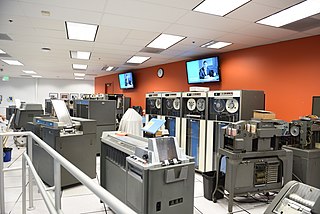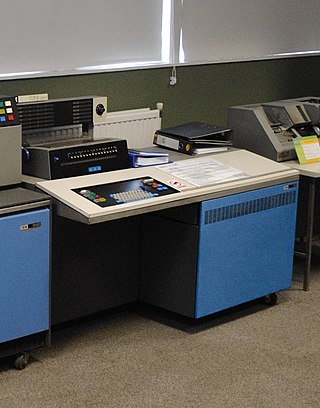Related Research Articles

The IBM 3270 is a family of block oriented display and printer computer terminals introduced by IBM in 1971 and normally used to communicate with IBM mainframes. The 3270 was the successor to the IBM 2260 display terminal. Due to the text color on the original models, these terminals are informally known as green screen terminals. Unlike a character-oriented terminal, the 3270 minimizes the number of I/O interrupts required by transferring large blocks of data known as data streams, and uses a high speed proprietary communications interface, using coaxial cable.

A line printer prints one entire line of text before advancing to another line. Most early line printers were impact printers.

The IBM 1401 is a variable-wordlength decimal computer that was announced by IBM on October 5, 1959. The first member of the highly successful IBM 1400 series, it was aimed at replacing unit record equipment for processing data stored on punched cards and at providing peripheral services for larger computers. The 1401 is considered by IBM to be the Ford Model-T of the computer industry due to its mass appeal. Over 12,000 units were produced and many were leased or resold after they were replaced with newer technology. The 1401 was withdrawn on February 8, 1971.

A newline is a control character or sequence of control characters in character encoding specifications such as ASCII, EBCDIC, Unicode, etc. This character, or a sequence of characters, is used to signify the end of a line of text and the start of a new one.

A computer terminal is an electronic or electromechanical hardware device that can be used for entering data into, and transcribing data from, a computer or a computing system. The teletype was an example of an early-day hard-copy terminal and predated the use of a computer screen by decades. Starting in the mid-1970s with machines such as the Sphere 1, Sol-20, and Apple I, terminal circuitry began to be integrated into personal and workstation computer systems, with the computer handling character generation and outputting to a CRT display such as a computer monitor or, sometimes, a consumer TV.
Job Control Language (JCL) is a name for scripting languages used on IBM mainframe operating systems to instruct the system on how to run a batch job or start a subsystem. The purpose of JCL is to say which programs to run, using which files or devices for input or output, and at times to also indicate under what conditions to skip a step. Parameters in the JCL can also provide accounting information for tracking the resources used by a job as well as which machine the job should run on.

The IBM 1130 Computing System, introduced in 1965, was IBM's least expensive computer at that time. A binary 16-bit machine, it was marketed to price-sensitive, computing-intensive technical markets, like education and engineering, succeeding the decimal IBM 1620 in that market segment. Typical installations included a 1 megabyte disk drive that stored the operating system, compilers and object programs, with program source generated and maintained on punched cards. Fortran was the most common programming language used, but several others, including APL, were available.
Disk Operating System/360, also DOS/360, or simply DOS, is the discontinued first member of a sequence of operating systems for IBM System/360, System/370 and later mainframes. It was announced by IBM on the last day of 1964, and it was first delivered in June 1966. In its time, DOS/360 was the most widely used operating system in the world.

The IBM 1403 line printer was introduced as part of the IBM 1401 computer in 1959 and had an especially long life in the IBM product line.

The IBM 1132 line printer was the normal printer for the IBM 1130 computer system. It printed 120 character lines at 80 lines per minute. The character set consisted of numbers, upper-case letters and some special characters.

Uniscope was a class of computer terminals made by Sperry Rand Corporation, Univac Division, and successors since 1964 that were normally used to communicate with Univac mainframes. As such, it was the successor to various models of Teletype. Due to the text color on the original models, these terminals are informally known as green screen terminals.
KDF8 was an early British computer built by English Electric as a version of the RCA 501. By producing a software-compatible system, the intention was to reduce time and cost to develop software. However, the lengthy process of developing manufacturing capability meant that the system was soon outpaced by systems from other vendors. Only a few systems were sold during its 5 years of production. Due to the consolidation of the British computer industry, English Electric's computer division became one of the components of what would become ICL.
ASA control characters are simple printing command characters used to control the movement of paper through line printers. These commands are presented as special characters in the first column of each text line to be printed, and affect how the paper is advanced before the line is printed. The remainder of the line is printed starting in the first printable position.

From the invention of computer programming languages up to the mid-1970s, most computer programmers created, edited and stored their programs line by line on punch cards.

CPT Corporation was founded in 1971 by Dean Scheff in Minneapolis, Minnesota, with co-founders James Wienhold and Richard Eichhorn. CPT first designed, manufactured, and marketed the CPT 4200, a dual-cassette-tape machine that controlled a modified IBM Selectric typewriter to support text editing and word processing.

A carriage control tape was a loop of punched tape that was used to synchronize rapid vertical page movement in most IBM and many other line printers from unit record days through the 1960s. The tape loop was as long as the length of a single page. A pin wheel moved the tape accurately using holes in the center of the tape. A hole punched in one of the other channels represented a particular position on the page. Channel one was typically used to indicate the top of the page and might be the only channel used. Another channel might indicate the summary line on an invoice, enabling rapid skipping to that line. IBM provides a special manual punch that allowed accurate placement of the channel punches. Skipping occurred under computer control, but a form feed switch on the printer control panel allowed a manual skip to the top of the page. The tapes could be easily changed when new, continuously fed forms were loaded into the printer.
IBM 3740 Data Entry System was a data entry system that was announced by IBM in 1973. It recorded data on an 8" diskette, a new recording medium from IBM, for fast, flexible, efficient data entry to either high-production, centralized operations or to decentralized, remote operations. The "Diskette" was more commonly known as an 8-inch floppy disk.

The IBM 1443 Printer is an obsolete computer line printer used in the punched card era. It was offered in three models: Models 1, 2 and N1; the last two could print up to 240 lines per minute (LPM) with a full character set.
The IBM 5280 was designed to compete with the data entry products that were available at the time. The IBM 3740 was the major data entry capability available to convert the data collected at the source, whether high volume, distributed or locally gathered, to make it available in digitized form in databases that were available to the managers and other users, and to make sure that the information was saved securely in storage for future reference. The IBM 5280 followed the design lead of the IBM 3740 but was totally programmable, enhanced the speed and storage of the processor, the speed and amount of available memory for the software to use, the size and clarity of the display, and afforded multiple diskette drives with larger capacity on each diskette. And, it sported an enhanced styling.
References
- z/OS DFSMS Using Data Sets -> Using Optional Control Characters
- PSF for z/OS: User's Guide -> Using carriage control characters in line data records
- "Advanced Function Presentation - Programming Guide and Line Data Reference -> Chapter 2. Line Data and MO:DCA (AFP) Data -> Line Data" (PDF). Archived from the original (PDF) on 2016-05-29.
- ↑ IBM Corporation (August 2009). Enterprise COBOL for z/OS Language Reference (PDF). pp. 478–482. Retrieved June 30, 2020.